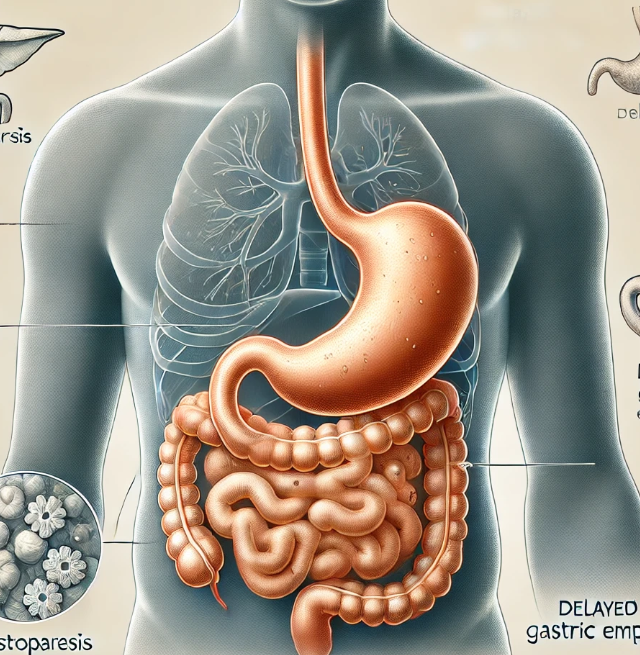
Discover the key differences between gastritis vs. gastroparesis, two distinct gastrointestinal conditions. Learn about symptoms, causes, treatments, and when to seek medical care.
Introduction:
Have you ever experienced persistent stomach pain or discomfort and wondered if it could be gastritis or gastroparesis? These two gastrointestinal conditions can cause overlapping symptoms but are fundamentally different in their causes, diagnosis, and treatment. In this article, we’ll explore the key differences between gastritis and gastroparesis, helping you understand their unique characteristics and guiding you on how to manage them effectively. Whether you’re a curious reader or looking for expert insights, you’ve come to the right place!
What Is Gastritis? (click here to learn)
What Is Gastroparesis?
Definition
Gastroparesis is a chronic condition characterized by delayed emptying of the stomach’s contents into the small intestine without any physical blockage or obstruction. It is essentially a problem with the stomach’s motility, where its normal muscular contractions are weakened or fail to occur.
Common Causes
Diabetes: The most common cause, as prolonged high blood sugar can damage the vagus nerve, which controls stomach muscles.
Post-surgical complications: Damage to the vagus nerve during abdominal surgeries.
Idiopathic origins: In some cases, no identifiable cause is found.
Other conditions: Parkinson’s disease, hypothyroidism, or systemic diseases like scleroderma.
Symptoms
Bloating: Feeling of fullness or tightness in the abdomen after eating.
Early satiety: Becoming full quickly after beginning a meal.
Nausea and vomiting: Particularly of undigested food several hours after eating.
Abdominal pain: A less common symptom but can occur in some cases.
Weight loss and malnutrition: Due to poor absorption and limited intake of nutrients.
Diagnostic Tools
Gastric Emptying Study: A nuclear medicine test where the time it takes for food to leave the stomach is measured.
Smart Pill Test: Ingesting a capsule that tracks gastrointestinal transit times wirelessly.
Endoscopy or imaging tests: Used to rule out obstructions or structural abnormalities that could mimic gastroparesis.
Treatment Options
Medications:
–Prokinetics: Medications like metoclopramide or domperidone to enhance stomach motility.
– Antiemetics: Drugs to reduce nausea and vomiting, such as ondansetron.
Dietary Modifications:
-Eating small, frequent meals.
-Avoiding high-fat and high-fiber foods that slow digestion.
-Incorporating liquid or pureed meals for easier digestion.
Surgical Interventions:
– Gastric electrical stimulation: Implanting a device to stimulate stomach muscles.
– Jejunostomy tube: Bypassing the stomach for severe cases.
Gastroparesis management focuses on symptom relief, addressing the underlying cause (if identified), and maintaining nutritional health to improve quality of life.
Key Differences Between Gastritis vs. Gastroparesis
Underlying Causes gastritis vs. gastroparesis
Gastritis:
Involves inflammation or irritation of the stomach lining, often caused by: Helicobacter pylori infection
Overuse of NSAIDs
Alcohol consumption
Autoimmune conditions or stress
Gastroparesis:
Results from delayed stomach emptying due to impaired motility, commonly linked to: Diabetes (vagus nerve damage)
Post-surgical nerve injury
Idiopathic or systemic conditions
Symptoms
Overlapping Symptoms:
Both can cause nausea, vomiting, and a sense of abdominal discomfort.
Distinct Symptoms gastritis vs. gastroparesis :
Gastritis: Burning or gnawing pain in the upper abdomen.
Symptoms often worsen on an empty stomach.
Gastroparesis: Bloating, early satiety, and vomiting of undigested food hours after eating.
Symptoms typically occur after meals and are associated with delayed stomach emptying.
Diagnosis gastritis vs. gastroparesis
Gastritis Diagnostic Tools:
– Endoscopy: Visualizing the stomach lining to confirm inflammation or ulcers.
– Biopsy: Testing for H. pylori infection or other pathological changes.
– Blood or stool tests: To detect infection or monitor inflammation markers.
Gastroparesis Diagnostic Tools:
– Gastric Emptying Study: Measures the time food takes to leave the stomach.
– Smart Pill Test: Tracks transit times of the digestive system.
– Rule-out imaging: To exclude mechanical obstructions.
Treatment Approaches gastritis vs. gastroparesis
– Gastritis:
Focuses on reducing inflammation and addressing the underlying cause: Proton pump inhibitors (PPIs) or H2 blockers to reduce stomach acid.
Antibiotics for H. pylori eradication.
Lifestyle changes, such as avoiding alcohol, spicy foods, and NSAIDs.
– Gastroparesis:
Centers on improving stomach motility and symptom relief: Prokinetics to stimulate gastric movement.
Anti-nausea medications for symptom control.
Dietary adjustments, such as eating smaller, low-fat, and low-fiber meals.
By understanding these fundamental differences, healthcare providers and patients can approach these conditions more effectively, ensuring accurate diagnosis and targeted treatment strategies.
Overlapping Symptoms and Misdiagnosis gastritis vs. gastroparesis:
Why Symptoms May Appear Similar
Both gastritis and gastroparesis ( gastritis vs. gastroparesis ) can present with common gastrointestinal complaints such as:
Nausea and vomiting.
Abdominal discomfort or pain.
Loss of appetite.
These overlapping symptoms can make it challenging to distinguish between the two conditions based on clinical presentation alone, leading to potential delays or inaccuracies in diagnosis.
Importance of a Thorough Medical Evaluation
Comprehensive History:
Assessing the onset, frequency, and triggers of symptoms.
Understanding medical history, including use of medications (e.g., NSAIDs) or conditions like diabetes.
Physical Examination:
Evaluating signs of inflammation or delayed gastric emptying.
Diagnostic Testing: ( gastritis vs. gastroparesis )
Gastritis requires tools like endoscopy and H. pylori testing.
Gastroparesis is diagnosed through gastric motility studies.
Proper evaluation ensures an accurate diagnosis and avoids unnecessary or ineffective treatments.
When to Suspect One Over the Other Based on Symptom Patterns gastritis vs. gastroparesis
– gastritis vs. gastroparesis indicators =
Gastritis Indicators:
– Burning or gnawing pain in the upper abdomen.
– Symptoms often linked to specific triggers such as spicy foods or fasting.
– May include black or tarry stools in severe cases (indicating bleeding).
Gastroparesis Indicators:
– Feeling full after eating small amounts (early satiety).
– Persistent bloating and vomiting undigested food several hours post-meal.
– Strong association with diabetes or post-surgical history.
Lifestyle and Dietary Changes for Management gastritis vs. gastroparesis
Gastritis-Focused Dietary Tips
To reduce inflammation and promote healing of the stomach lining:
Avoid irritants:
Spicy foods, which can aggravate inflammation.
Caffeine and alcohol, known to increase stomach acid production.
Choose gentle foods:
Non-acidic fruits (e.g., bananas, melons).
Whole grains and lean proteins.
Eat smaller, frequent meals:
Prevents excessive acid production.
Stay hydrated:
Drink water instead of acidic beverages like soda or citrus juices.
Gastroparesis-Focused Dietary Strategies
To ease digestion and support stomach motility:
Small, frequent meals:
Reduces the workload on the stomach for quicker emptying.
Low-fiber and low-fat diets:
Fiber and fat slow gastric emptying, so these should be minimized.
Incorporate easily digestible foods:
Pureed or blended meals, soups, and smoothies.
Chew food thoroughly:
Breaks down food into smaller particles for easier digestion.
Avoid lying down after eating:
Helps prevent delayed gastric emptying and reflux symptoms.
General Tips for Gut Health
Maintain a balanced diet:
Include probiotics (yogurt, kefir) and prebiotics (onions, garlic) to support gut flora.
Stay hydrated:
Proper hydration aids digestion and nutrient absorption.
Limit processed foods:
Reduces exposure to additives that may irritate the gut.
Manage stress:
High stress levels can exacerbate symptoms of both gastritis and gastroparesis.
Avoid overeating:
Helps prevent bloating and discomfort.
Implementing these lifestyle and dietary adjustments can significantly alleviate symptoms and improve quality of life for individuals with gastritis or gastroparesis, while promoting overall gut health.
When to See a Doctor ( gastritis vs. gastroparesis cases )
Warning Signs That Require Immediate Medical Attention
Certain symptoms suggest a more severe underlying problem and warrant prompt evaluation:
Persistent or severe abdominal pain:
Especially if it disrupts daily activities or sleep.
Vomiting blood or coffee-ground-like material:
Indicates possible gastrointestinal bleeding.
Black, tarry stools:
A sign of bleeding in the stomach or upper gastrointestinal tract.
Unexplained weight loss:
Could point to malnutrition or an underlying condition like gastroparesis.
Severe dehydration:
From frequent vomiting or inability to keep food down.
Symptoms not improving with home remedies:
Chronic discomfort, bloating, or nausea persisting despite lifestyle or dietary changes.
Role of Gastroenterologists in Diagnosing and Treating Both Conditions
A specialist can provide a tailored approach to managing gastritis and gastroparesis:
Comprehensive Evaluation:
Conducting endoscopy for gastritis to detect inflammation or ulcers.
Performing gastric emptying studies or motility tests for gastroparesis.
Personalized Treatment Plans:
Prescribing medications such as PPIs, antibiotics for gastritis, or prokinetics for gastroparesis.
Guiding patients on dietary modifications specific to each condition.
Advanced Interventions:
Gastric electrical stimulation or surgery for severe gastroparesis.
Biopsies during endoscopy to evaluate for H. pylori or autoimmune gastritis.
Long-Term Management:
Monitoring chronic conditions like diabetes to prevent gastroparesis.
Addressing stress and lifestyle factors that exacerbate gastritis.
Seeking medical care early can prevent complications, improve symptom control, and ensure a better quality of life for patients with gastritis or gastroparesis.
FAQs About gastritis vs. gastroparesis
Can You Have Both Conditions at the Same Time?
Yes, it is possible to have both conditions simultaneously.
Overlap in symptoms like nausea, vomiting, and abdominal discomfort can occur, especially in patients with complex medical histories.
Conditions like diabetes or prolonged use of NSAIDs can contribute to the development of both gastritis (via stomach lining irritation) and gastroparesis (due to nerve damage).
Diagnosis of one condition does not rule out the other; thorough evaluation is essential.
Are There Specific Tests to Differentiate Them? (gastritis vs. gastroparesis)
Gastritis:
– Endoscopy: Allows direct visualization of the stomach lining for inflammation or ulcers.
– H. pylori Testing: Blood, stool, or breath tests to identify infection.
– Biopsy: Taken during endoscopy to confirm the presence of gastritis or rule out other causes.
Gastroparesis:
– Gastric Emptying Study: Measures the time taken for food to leave the stomach.
– Smart Pill Test: Monitors motility throughout the digestive tract.
– Exclusion of Mechanical Obstruction: Imaging studies like CT scans or upper GI series to rule out structural causes.
How Do Diabetes and Lifestyle Choices Impact These Conditions gastritis vs. gastroparesis?
Diabetes:
Gastritis: Chronic high blood sugar levels can weaken the immune system, increasing the risk of H. pylori infection.
Gastroparesis: Prolonged poorly controlled diabetes can damage the vagus nerve, leading to delayed gastric emptying.
Lifestyle Choices gastritis vs. gastroparesis :
For Gastritis:
Harmful habits: Excessive alcohol intake, smoking, and frequent use of NSAIDs exacerbate inflammation.
Beneficial habits: Balanced diets, stress reduction, and limiting irritants help prevent or manage gastritis.
For Gastroparesis:
Dietary strategies: Eating smaller, low-fat meals improves gastric motility.
Physical activity: Light exercise post-meals can aid digestion and promote gastric emptying.
Conclusion:
Understanding the key differences between gastritis and gastroparesis is essential for proper diagnosis and effective treatment. Both conditions can significantly impact quality of life, but with the right approach, they can be managed. If you’re experiencing symptoms, don’t hesitate to consult a healthcare professional. Stay informed, and take charge of your digestive health today!






